Alchemy of Aches
Vibeke Mascini - solo show
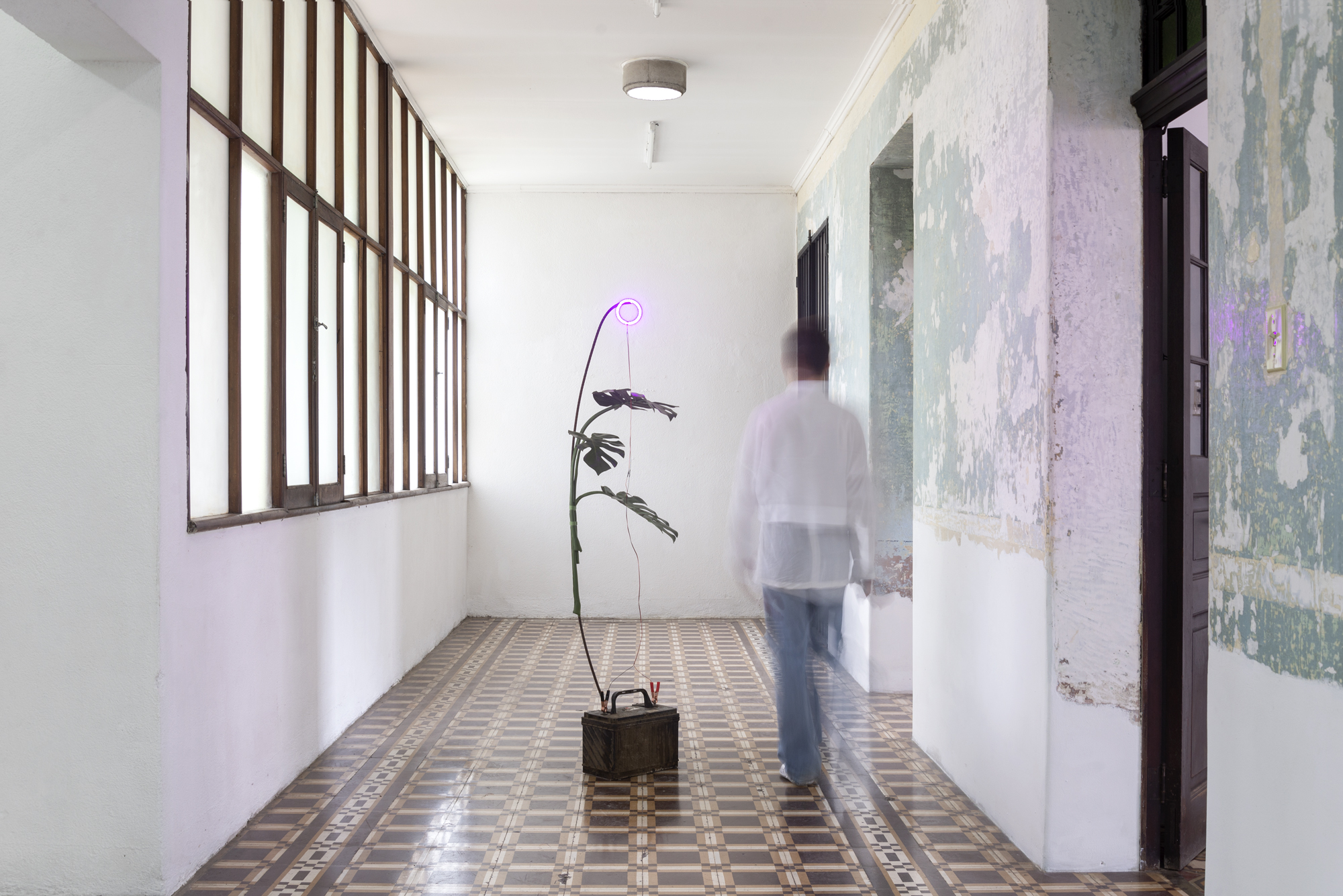
Alchemy of Aches
2023 Exhibition view Proyectos Ultravioleta, Guatemala City, Guatemala Photo: Margo Porres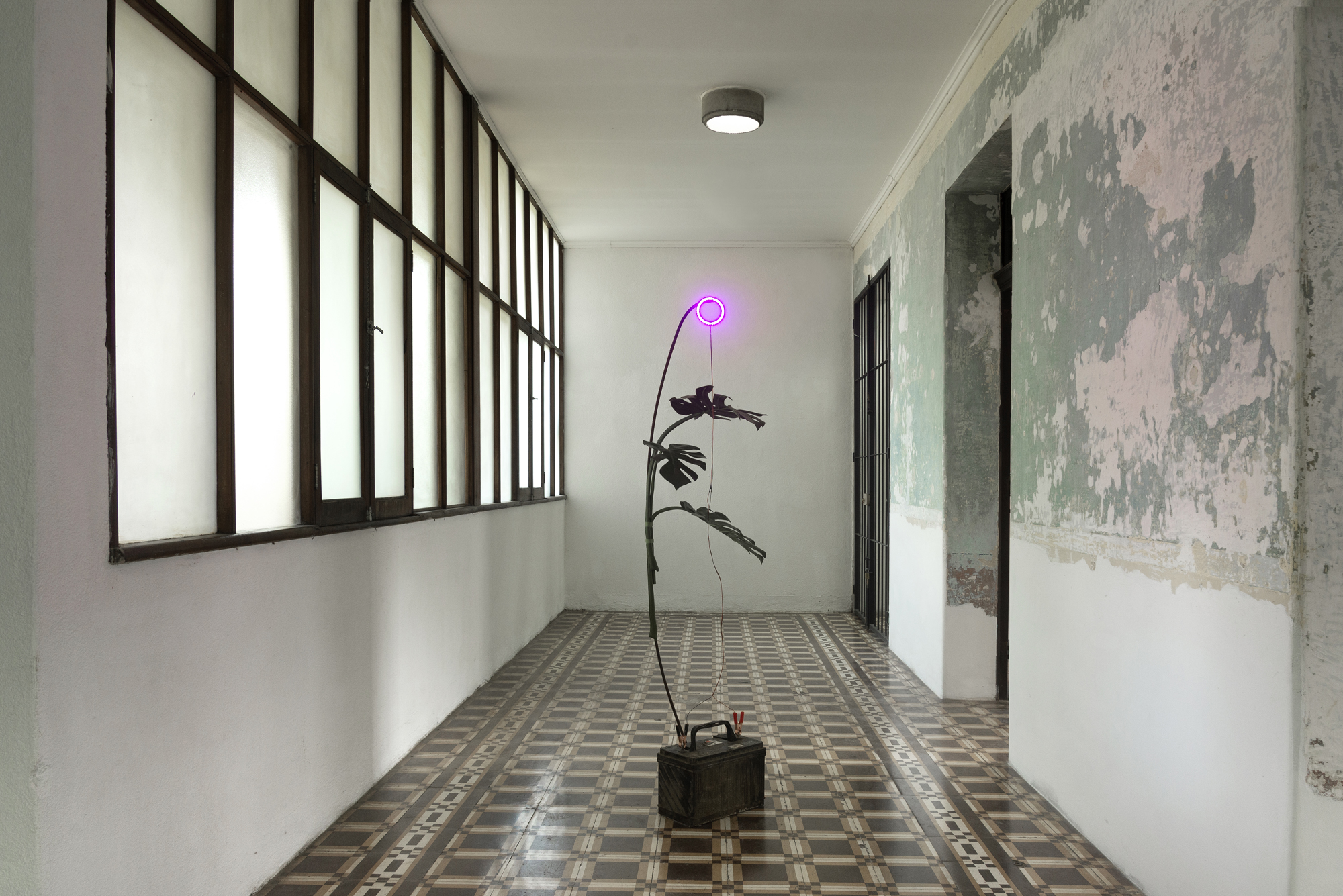
Alchemy of Aches
2023 Exhibition view Proyectos Ultravioleta, Guatemala City, Guatemala Photo: Margo Porres
Lixiviado
2023 Electricity from waste, repurposed car battery, dimmer, battery clamps, cable, artificial Monstera leaves, LED light, custom made iron mount, velcro strip 66 29/32 x 12 51/64 in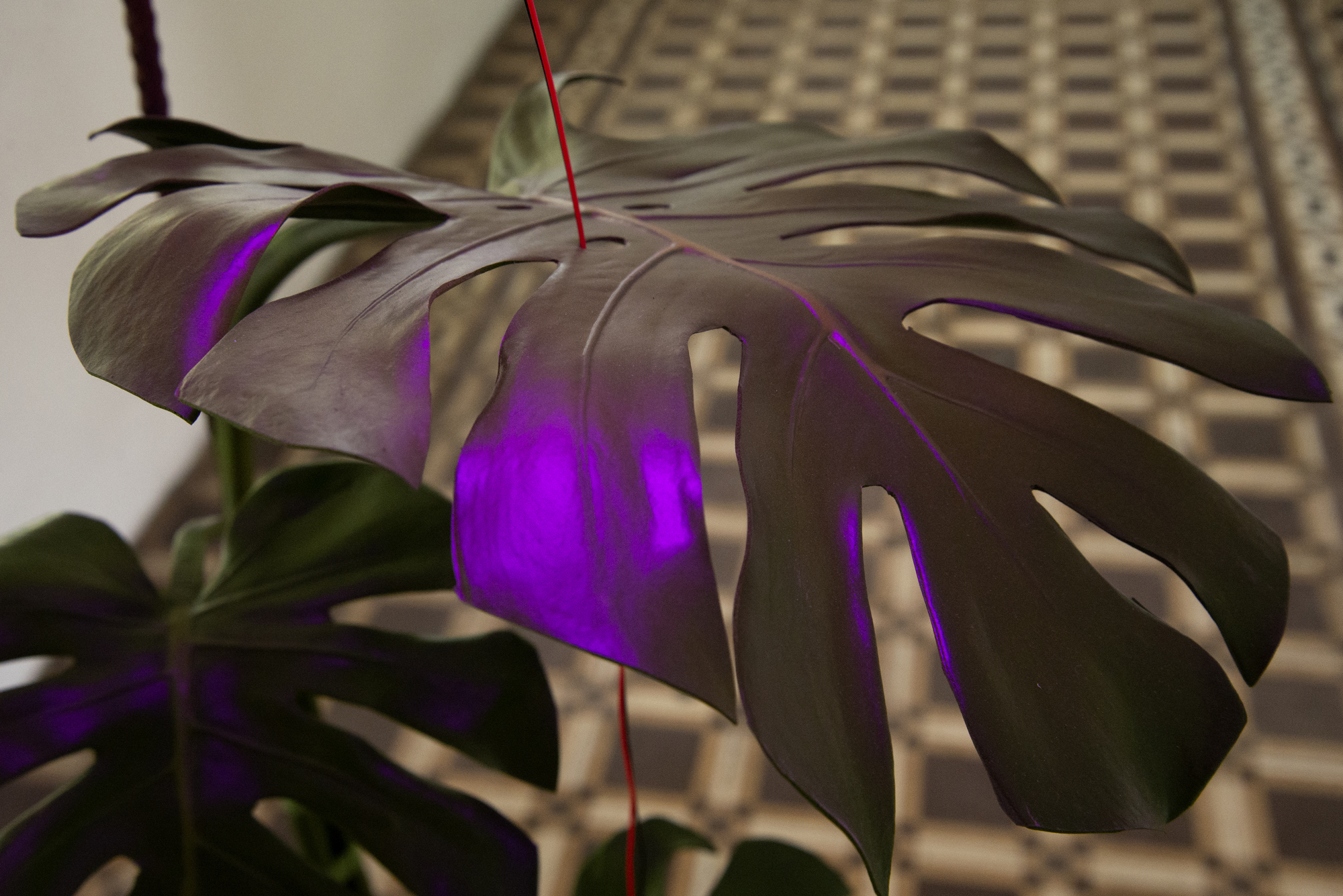
Alchemy of Aches
2023 (Lixiviado´s detail) Exhibition view Proyectos Ultravioleta, Guatemala City, Guatemala Photo: Margo Porres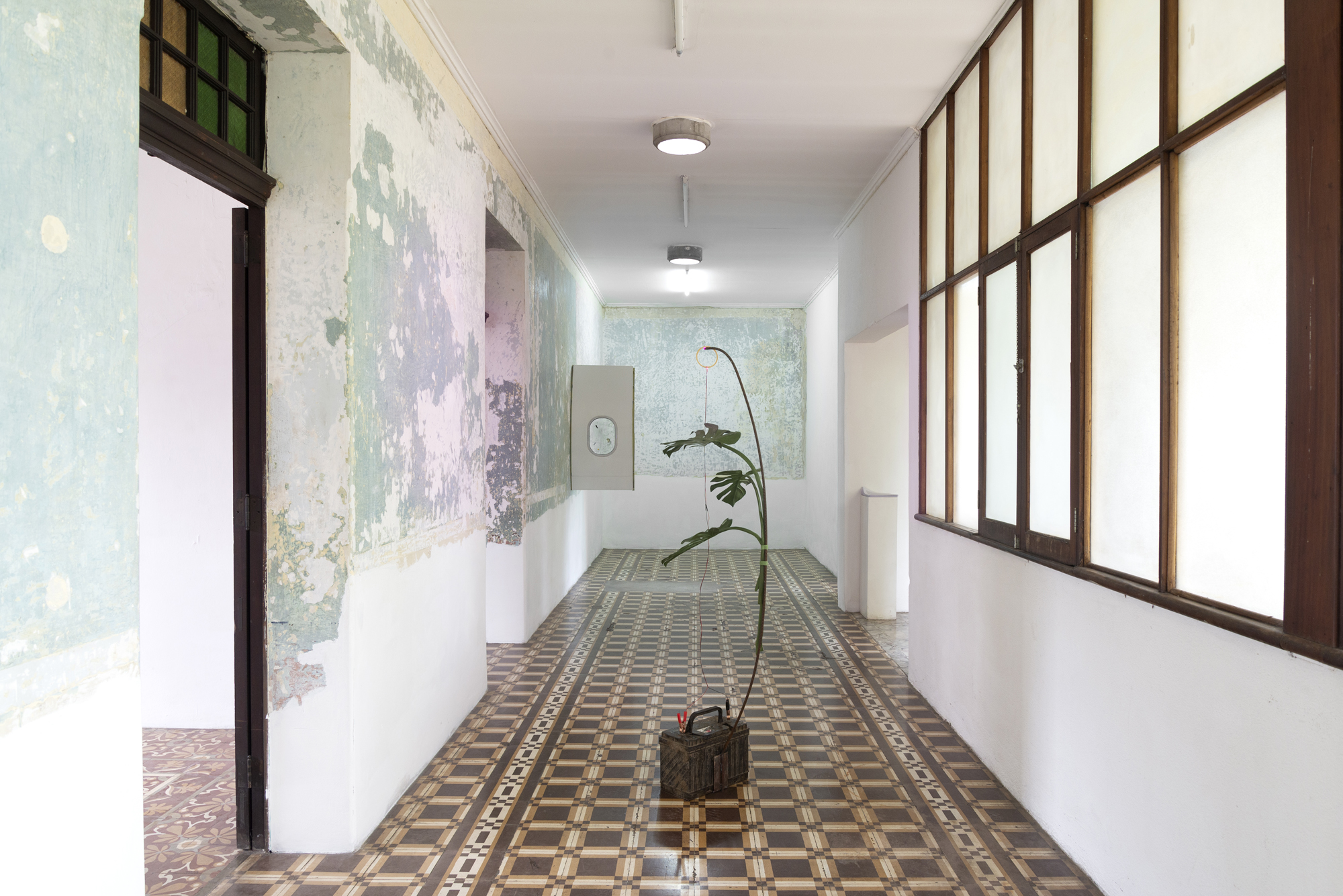
Alchemy of Aches
2023 Exhibition view Proyectos Ultravioleta, Guatemala City, Guatemala Photo: Margo Porres
Alchemy of Aches
2023 Exhibition view Proyectos Ultravioleta, Guatemala City, Guatemala Photo: Margo Porres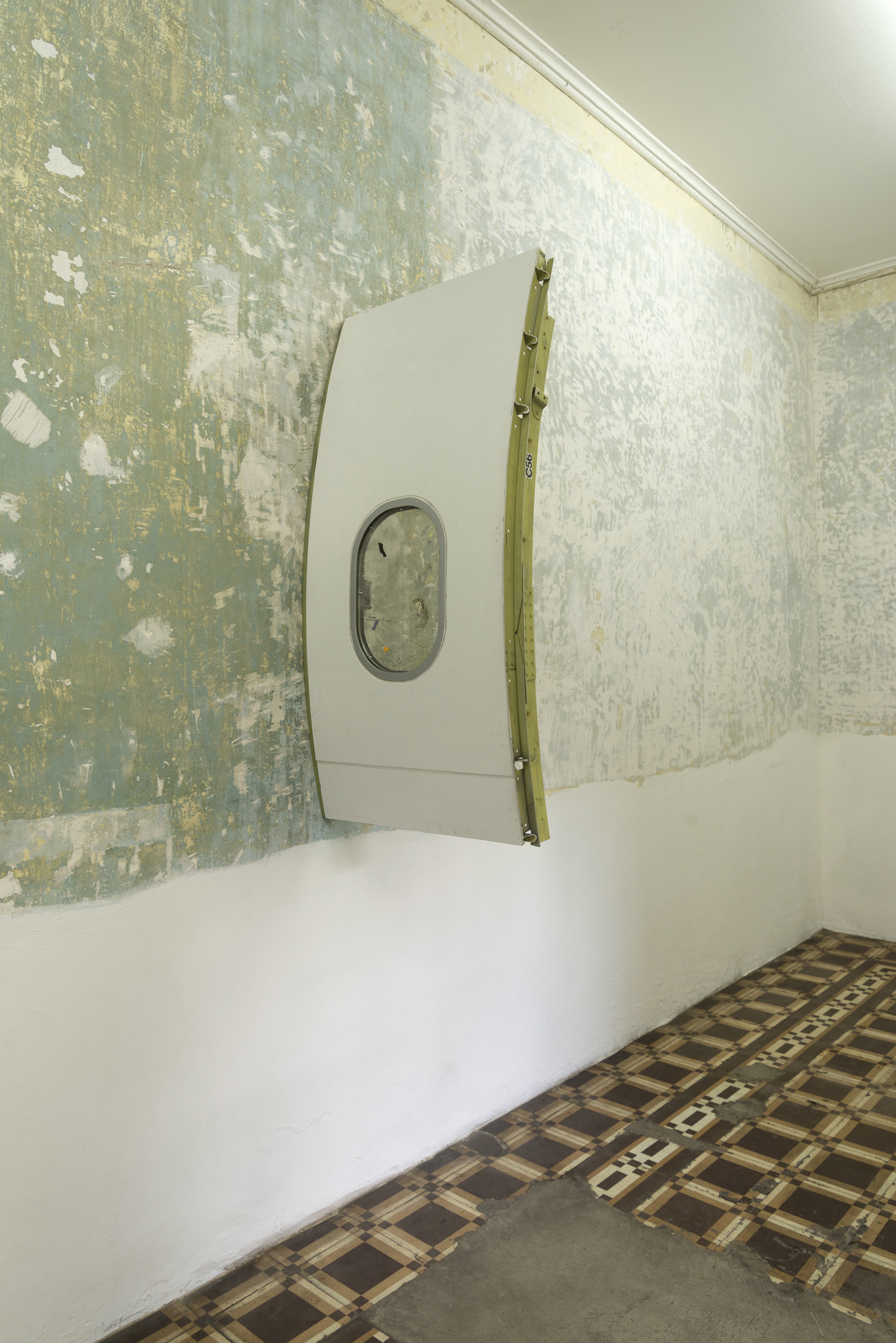
Dust Suns x
2023 Decayed moths and butterflies, static electricity enclosed within airplane windows and Optium acrylic, miniature stainless steel bolts and nuts, fortified aluminum airplane panel, custom made metal mount 44 31/64 x 22 53/64 x 4 21/64 in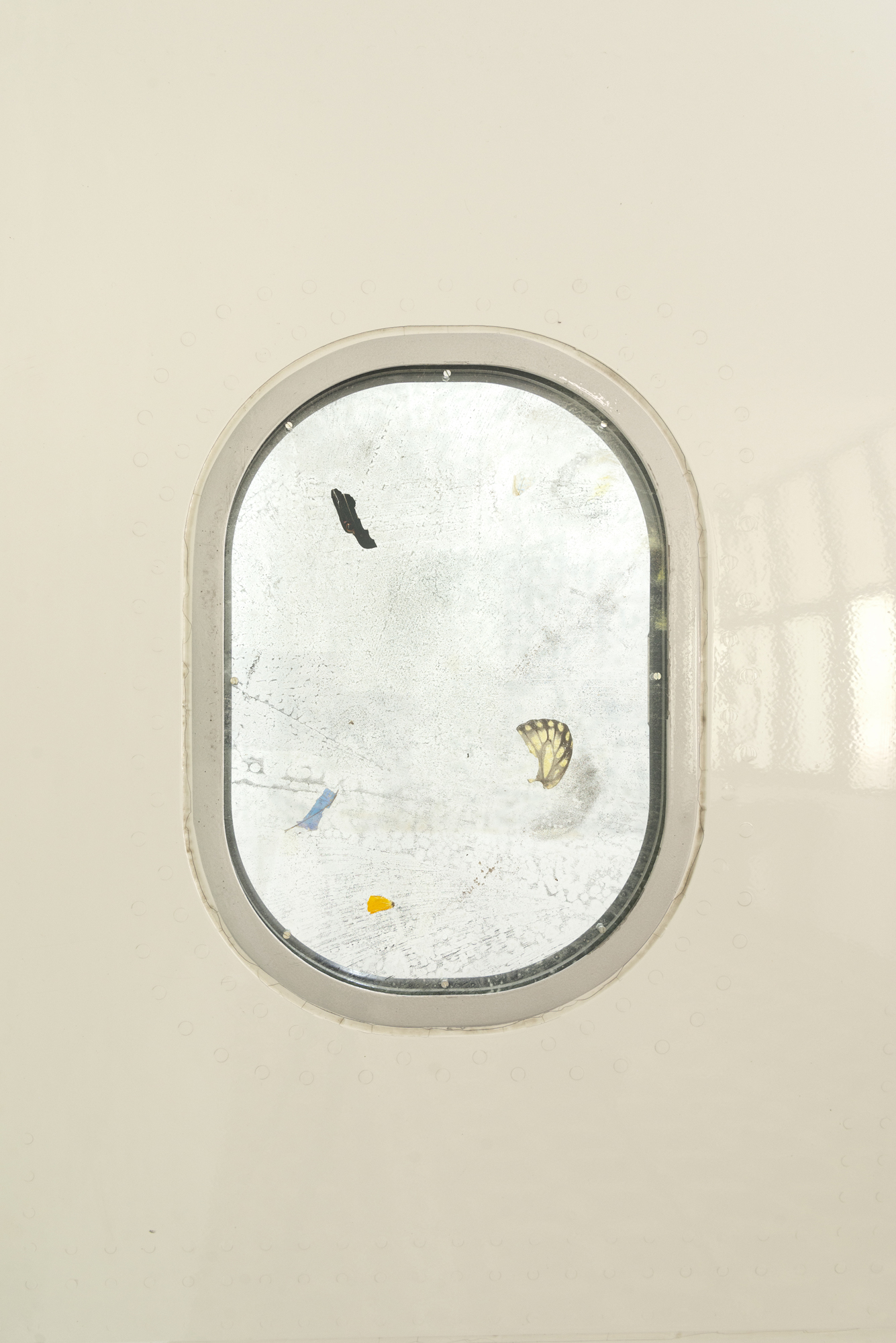
Alchemy of Aches
2023 (Dunt Suns x´s detail) Exhibition view Proyectos Ultravioleta, Guatemala City, Guatemala Photo: Margo Porres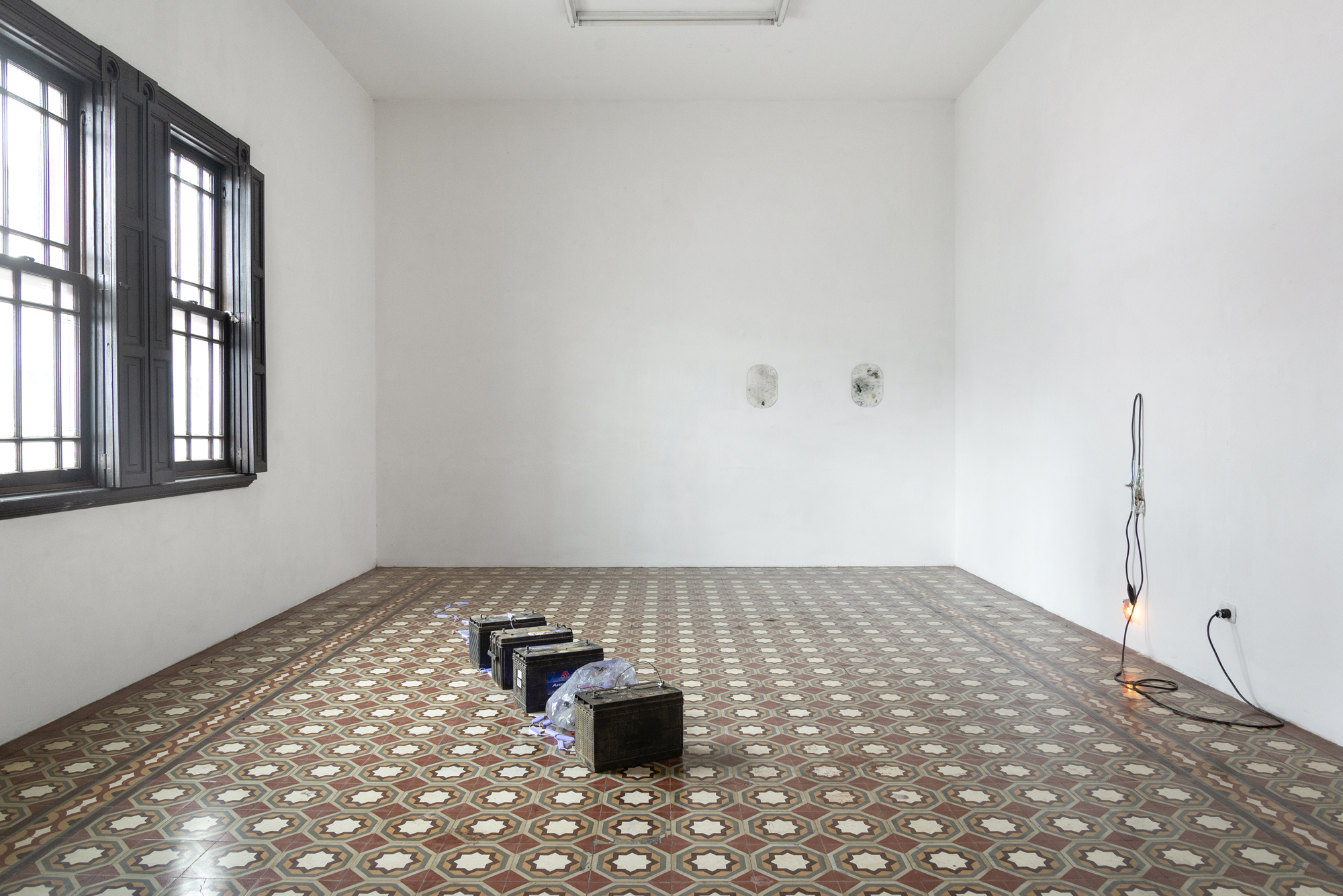
Alchemy of Aches
2023 Exhibition view Proyectos Ultravioleta, Guatemala City, Guatemala Photo: Margo Porres
Lixiviado
2023 Electricity from waste, 4 repurposed car batteries, dimmer, battery clamps, cable, resin, death hawk moths, LED light 8 21/32 x 12 63/64 x 121 29/64 in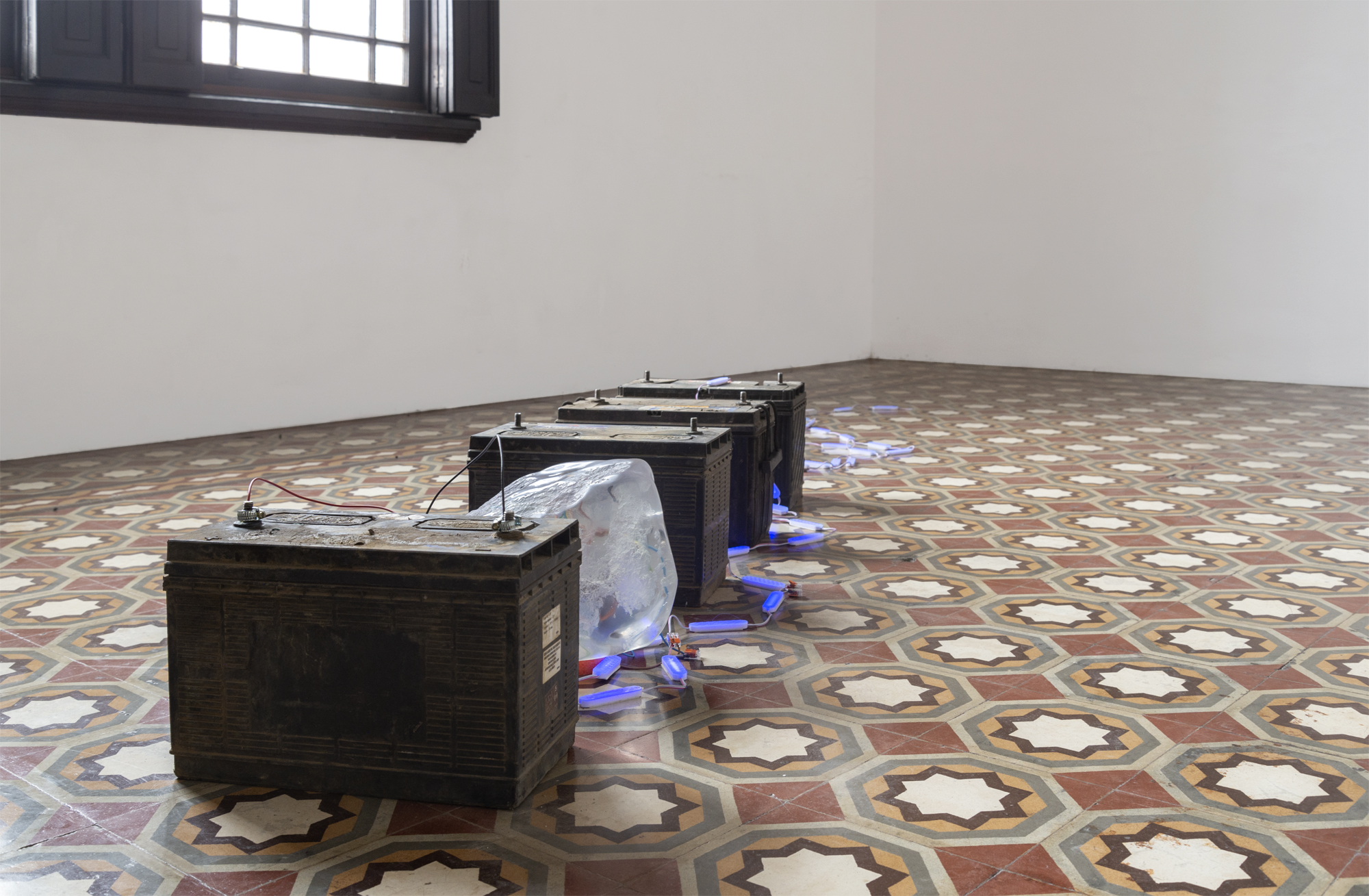
Lixiviado
2023 Electricity from waste, 4 repurposed car batteries, dimmer, battery clamps, cable, resin, death hawk moths, LED light 8 21/32 x 12 63/64 x 121 29/64 in
Lixiviado
2023 Electricity from waste, 4 repurposed car batteries, dimmer, battery clamps, cable, resin, death hawk moths, LED light 8 21/32 x 12 63/64 x 121 29/64 in
Jolt
2023 Extension cable, lever nut, resin, death hawk moth, LED light 50 x 51 3/16 in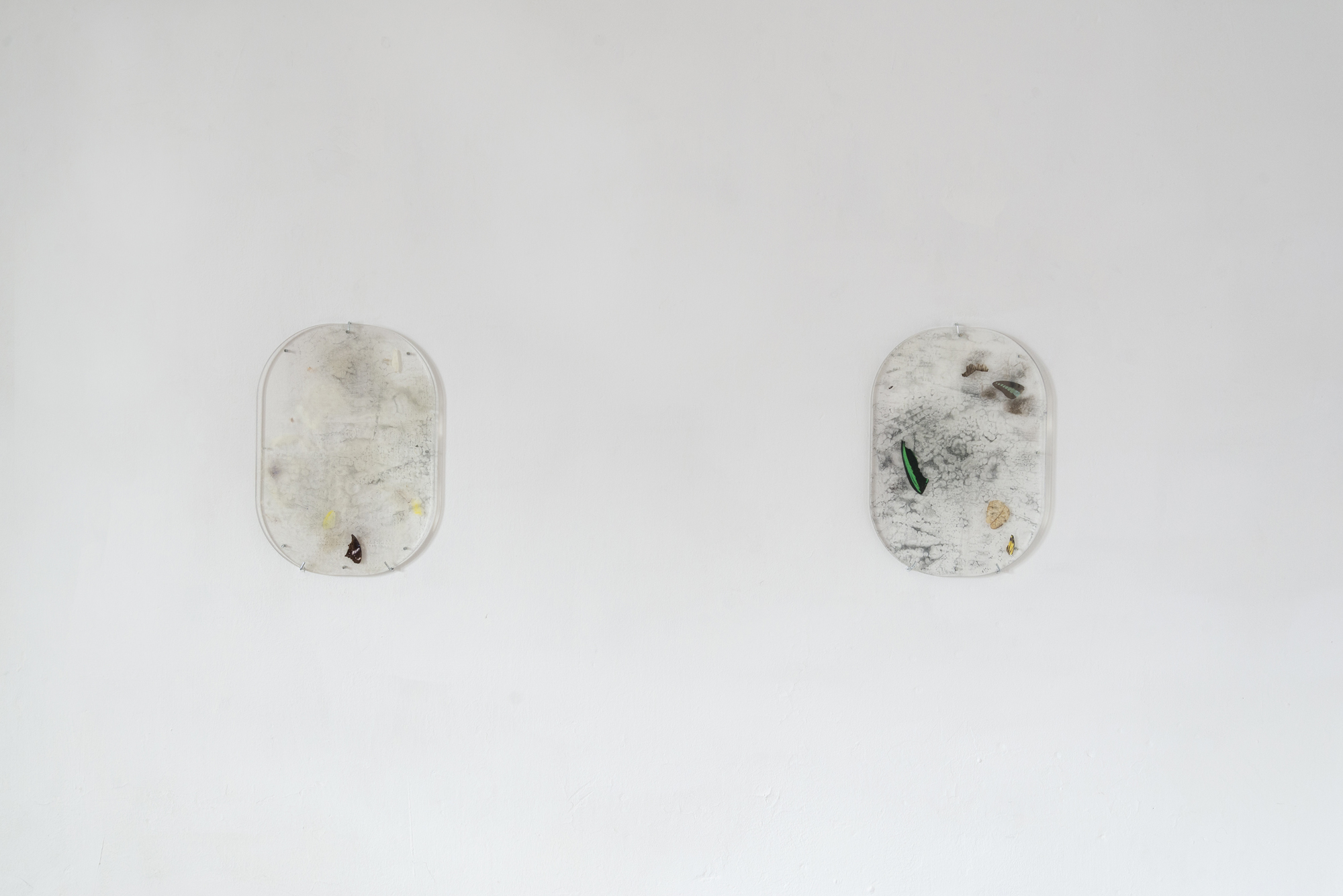
Alchemy of Aches
2023 Exhibition view Proyectos Ultravioleta, Guatemala City, Guatemala Photo: Margo Porres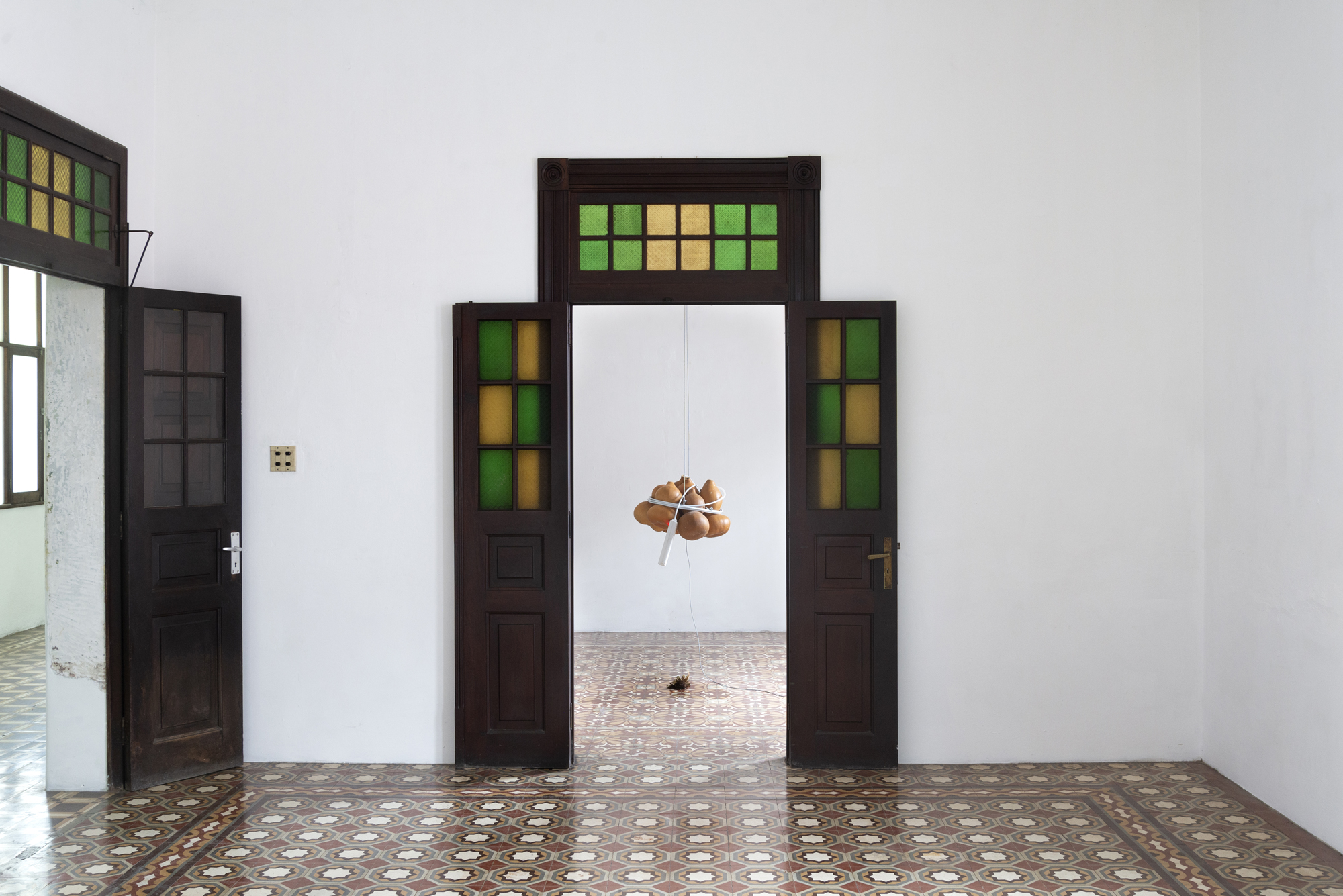
Alchemy of Aches
2023 Exhibition view Proyectos Ultravioleta, Guatemala City, Guatemala Photo: Margo Porres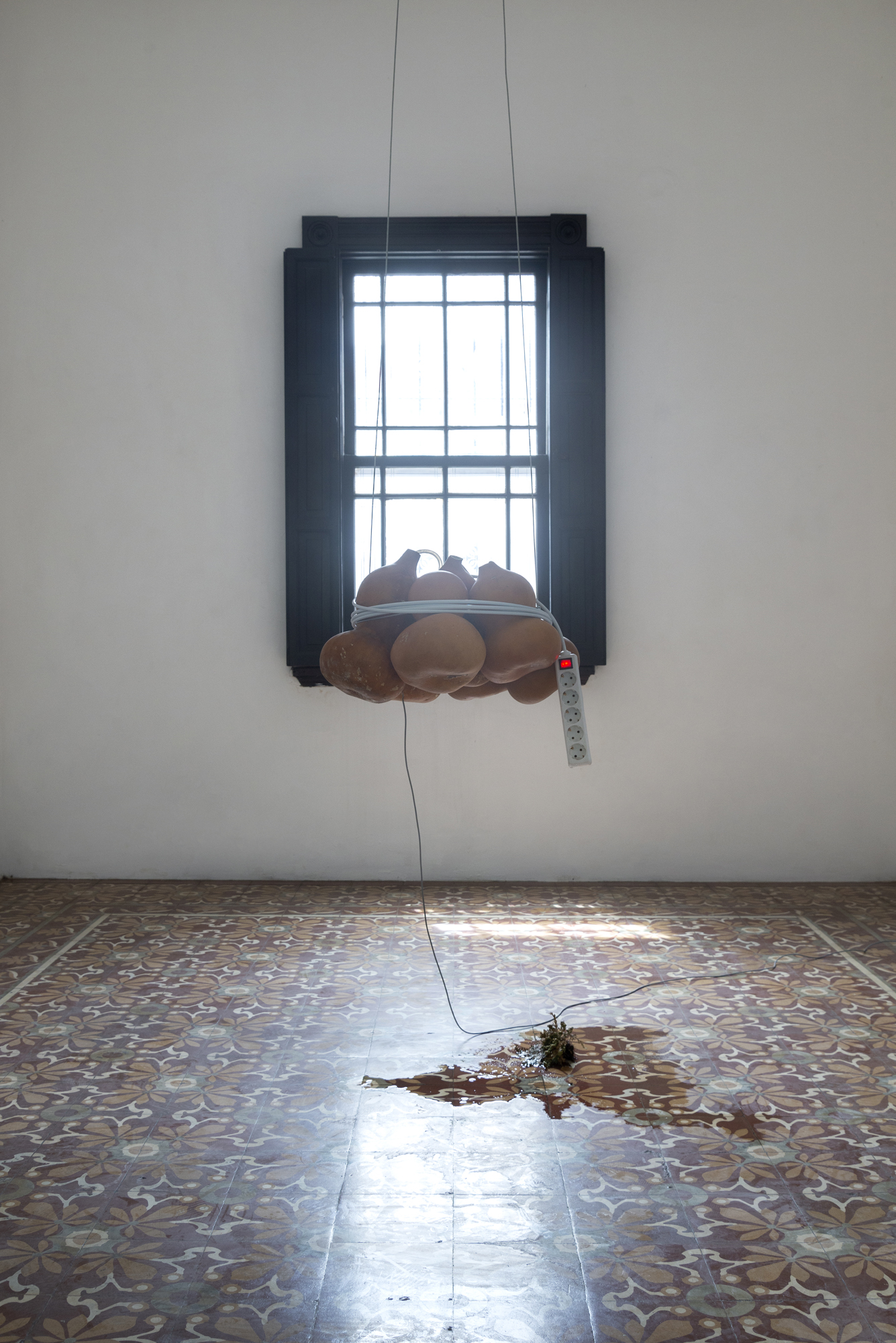
Aq’
2023 6 tecomates, water collected from the Rio Negro, tube, hydrolic pump, altered electric socket 145 9/32 x 106 19/64 x 19 11/16 in (70 51/64 in Ø)
Aq’
2023 6 tecomates, water collected from the Rio Negro, tube, hydrolic pump, altered electric socket 145 9/32 x 106 19/64 x 19 11/16 in (70 51/64 in Ø)
Aq’
2023 6 tecomates, water collected from the Rio Negro, tube, hydrolic pump, altered electric socket 145 9/32 x 106 19/64 x 19 11/16 in (70 51/64 in Ø)
Aq’
2023 6 tecomates, water collected from the Rio Negro, tube, hydrolic pump, altered electric socket 145 9/32 x 106 19/64 x 19 11/16 in (70 51/64 in Ø)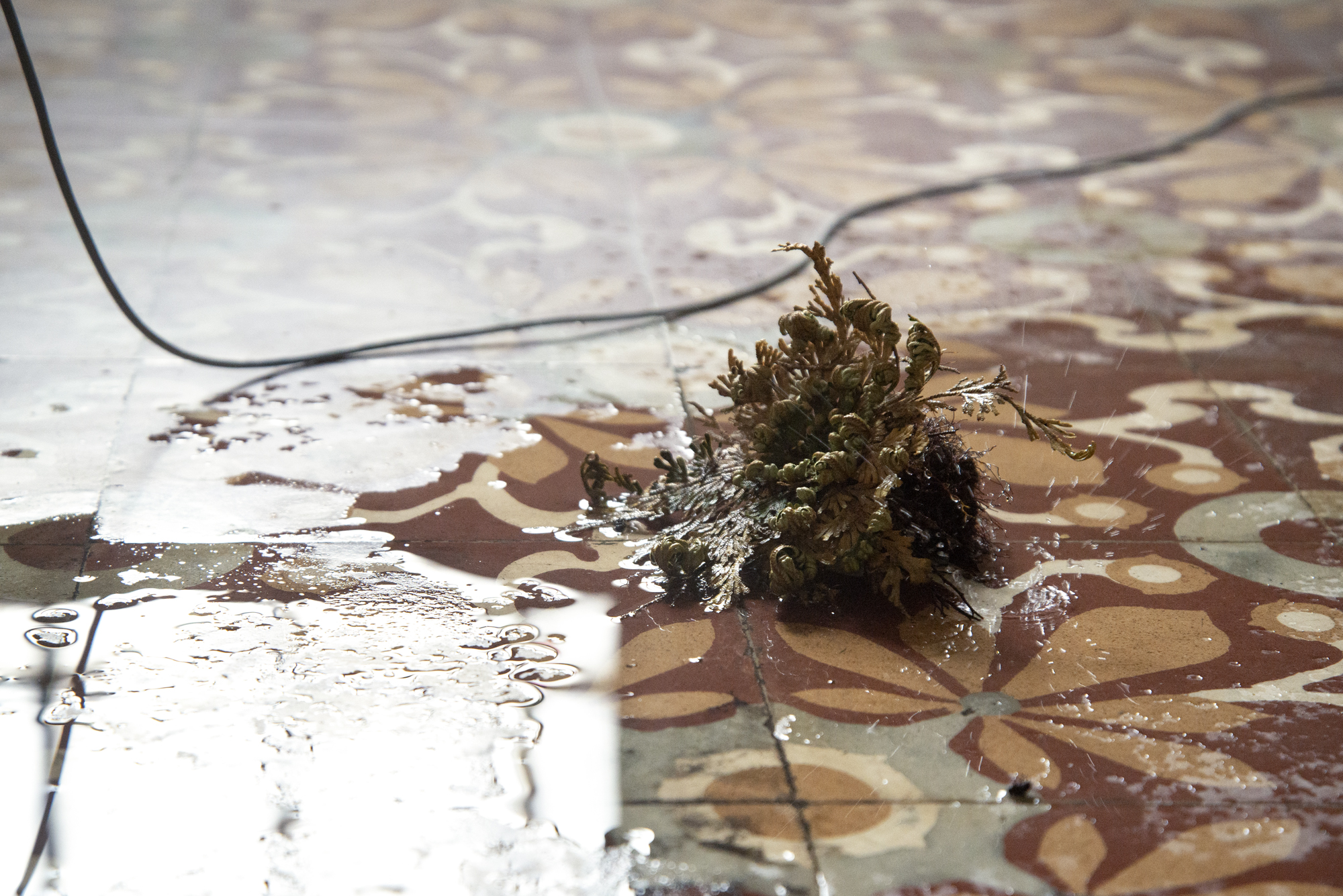
Aq’
2023 6 tecomates, water collected from the Rio Negro, tube, hydrolic pump, altered electric socket 145 9/32 x 106 19/64 x 19 11/16 in (70 51/64 in Ø)

Alchemy of Aches
2023 Exhibition view Proyectos Ultravioleta, Guatemala City, Guatemala Photo: Margo Porres
Alchemy of Aches
2023 Exhibition view Proyectos Ultravioleta, Guatemala City, Guatemala Photo: Margo Porres
Lixiviado
2023 Electricity from waste, repurposed car battery, dimmer, battery clamps, cable, artificial Monstera leaves, LED light, custom made iron mount, velcro strip 66 29/32 x 12 51/64 in
Alchemy of Aches
2023 (Lixiviado´s detail) Exhibition view Proyectos Ultravioleta, Guatemala City, Guatemala Photo: Margo Porres
Alchemy of Aches
2023 Exhibition view Proyectos Ultravioleta, Guatemala City, Guatemala Photo: Margo Porres
Alchemy of Aches
2023 Exhibition view Proyectos Ultravioleta, Guatemala City, Guatemala Photo: Margo Porres
Dust Suns x
2023 Decayed moths and butterflies, static electricity enclosed within airplane windows and Optium acrylic, miniature stainless steel bolts and nuts, fortified aluminum airplane panel, custom made metal mount 44 31/64 x 22 53/64 x 4 21/64 in
Alchemy of Aches
2023 (Dunt Suns x´s detail) Exhibition view Proyectos Ultravioleta, Guatemala City, Guatemala Photo: Margo Porres
Alchemy of Aches
2023 Exhibition view Proyectos Ultravioleta, Guatemala City, Guatemala Photo: Margo Porres
Lixiviado
2023 Electricity from waste, 4 repurposed car batteries, dimmer, battery clamps, cable, resin, death hawk moths, LED light 8 21/32 x 12 63/64 x 121 29/64 in
Lixiviado
2023 Electricity from waste, 4 repurposed car batteries, dimmer, battery clamps, cable, resin, death hawk moths, LED light 8 21/32 x 12 63/64 x 121 29/64 in
Lixiviado
2023 Electricity from waste, 4 repurposed car batteries, dimmer, battery clamps, cable, resin, death hawk moths, LED light 8 21/32 x 12 63/64 x 121 29/64 in
Jolt
2023 Extension cable, lever nut, resin, death hawk moth, LED light 50 x 51 3/16 in
Alchemy of Aches
2023 Exhibition view Proyectos Ultravioleta, Guatemala City, Guatemala Photo: Margo Porres
Alchemy of Aches
2023 Exhibition view Proyectos Ultravioleta, Guatemala City, Guatemala Photo: Margo Porres
Aq’
2023 6 tecomates, water collected from the Rio Negro, tube, hydrolic pump, altered electric socket 145 9/32 x 106 19/64 x 19 11/16 in (70 51/64 in Ø)
Aq’
2023 6 tecomates, water collected from the Rio Negro, tube, hydrolic pump, altered electric socket 145 9/32 x 106 19/64 x 19 11/16 in (70 51/64 in Ø)
Aq’
2023 6 tecomates, water collected from the Rio Negro, tube, hydrolic pump, altered electric socket 145 9/32 x 106 19/64 x 19 11/16 in (70 51/64 in Ø)
Aq’
2023 6 tecomates, water collected from the Rio Negro, tube, hydrolic pump, altered electric socket 145 9/32 x 106 19/64 x 19 11/16 in (70 51/64 in Ø)
Aq’
2023 6 tecomates, water collected from the Rio Negro, tube, hydrolic pump, altered electric socket 145 9/32 x 106 19/64 x 19 11/16 in (70 51/64 in Ø)
The water that will be light has blood memory
Art is the presence of a mind in front of something that is already established. That mind searches for a loose thread, the hidden hole, that mind listens with the other senses, not with the ears; it sees with the other senses, not with the eyes; it touches with the other senses, not with the hands and like that, like someone that lifts a mantle, and reveals. And it is that which is already established that shows another state of its existence. It counts, thinks out loud, a voice which the artist listens to and must translate to its own language, one that can make that other reality of things a bit more tangible.
We enter home, we turn on the light. Just like that. We take of a wrapping, peel the fruit, break an egg, we throw it in the bin. Just like that. But where does the light come from. Where does the trash go.
These works are inversed travel instructions. The light goes onand we would say that the journey back is initiated, an intra-mural voyage through the energy cables that every so often reach light posts and continue being cables until they reach large energy repositories that move and go back in search of their origin. Until they reach a dam, and from that dam streams the peaceful trajectory of a river that one day was born from the bowels of the earth.
But these works are also the resurrection of other things, a trash dump that offers light, that activates movement. Waste that is capable of illuminating and revealing that there is no possible death, that in matter the energy moves with the very willpower of existence which transforms it all.
Vibeke captures the energy, contemplates it in her hands, changes its form, reorganizes it and with that makes that strand of willpower that pierces through everything a little more eloquent: what is alive and what is dead, the immense and the tiny, the beautiful and the terrible. She came to Guatemala and her search to find that well of eloquence took her to two places: the Chixoy hydroelectric dam in the Río Negro (Black River) and the basurero (dump) of zone 3. Disturbing. How much of the story of Guatemala can we tell from these two points.
Let’s imagine the map. One point in Guatemala City, another point in the place where the Verapaces and Quiché meet. One produces energy. The other one is a corpse of corpses, remain of remains, debris which are accumulated and are converted into the deity of waste, of what we no longer need, and in which, despite it all, there are flying butterflies.
I imagine Vibeke arriving at Río Negro, gobbling with her eyes that place that we would say is peaceful, but which little by little, start to talk to her, starts to thrust voices towards her, how are the voices at el Río Negro? Are they trapped screams at the riviera, are they claims and pleading? The echo of a massacre. The water which will be light has blood memory, and still that water turned into art illuminates once more the greens of the sleeping plants.
I imagine Vibeke arriving at the basurero of zone 3, perceiving the energy that parts from the waste of millions of people, where does that energy go?, does it rest eternally and sleep? could that energy once again become light? A city on top of which a city of trash grows. Trash which is now light and illuminates the miracle of a live plant.
The energy, of the body, of the earth, of the objects; that strange will that gave way to a far larger and more enigmatic road: the existence. Much is spoken about the spirit, the soul, or even about thought, but that pulse, that willpower which is repeated in cosmic and microscopic levels doesn’t have a correspondence with understanding, with the world of explanations in the end. Where does it come from? Why does it exist? And when it is turned off, where does it go? How does it transform? Which is its transit and metamorphosis?
From the organic to the inorganic the energy seems to be the language of everything, the word of the universe. Invisible like the thought and the matter, the job of the artist is the reorganization of the world in order to make tangible the intangible.
– Carmen Lucía Alvarado
Guatemala, October 20th, 2023
Proyectos Ultravioleta presents:
Vibeke Mascini
The Alchemy of Aches
—————————————
Using fluid media including video, installation, sound and text, Vibeke Mascini explores the sensorial scaling of abstract phenomena, with the intention to seek agency from intimacy. In long-term collaboration with scientists, engineers, government employees, and musicians she proposes the development of a conscious understanding of electric energy as a statement of interconnectedness and entanglement – between species, media and nature, matter and energy. By exploring the complex relationship between source and user, and focusing on the material implications of unlikely sources from which electricity is derived, Vibeke proposes installations where memories and mysterious sensorial experiences meet the newest technology of the rapidly growing field of energy storage systems.
Her unlikely sources of electricity include a whale carcass, a melting glacier, confiscated cocaine, and human remains, which she then shapes around associations with these electric agents, and their implication and tension of their destruction in the process of becoming fuel.
For her first exhibition at Proyectos Ultravioleta, Vibeke delves into the rippling presence of suffering peoples and ecologies that linger within the electric grid of Guatemala.
Alchemy of Aches is a research oriented presentation that combines site specific alterations of existing works and context specific collaborations. Oriented towards two new performative installations – which involve the energetically harnessing of methane fumes at the largest Basurero (waste disposal) site of Guatemala City, and the currents of the Chixoy hydraulic power station that was built after the caused a massacre of the Q’eqchi indigenous communities of the Río Negro (Black River) only a few decades ago – the show is an important new chapter in her ongoing interest into the fiction of a ‘neutral electricity’, by paying attention to signals of material and emotional distress.
In it, Vibeke aims to make a conscious proposal for the complex generative capacities of sites of destruction: one that acknowledges the importance of commemoration and justice.
Other exhibitions by these artists at Proyectos Ultravioleta:
-
To Name a Bird is to Sing With It
Amalia Pica
Guatemala
-
Art Basel 2024
Basel
-
Frieze NY 2024
New York
-
ARCO Madrid 2023
Madrid
-
The Night Dies by the Day, the Day Dies by the Night
Guatemala
-
Art Basel Miami Beach 2022
Miami Beach
-
Ríos de gente (Rivers of People)
Regina José Galindo
Guatemala City
-
Art Basel Miami 2021
Miami
-
Oído vegetal (Vegetal Ear)
Guatemala
-
Vortic 2021
Online
-
South South Veza 2021
New York
-
First Sunrises on Earth
Proyectos Ultravioleta, Guatemala City
-
NADA MIAMI 2019
Miami, USA
-
MECA 2019
San Juan, Puerto Rico
-
ART DÜSSELDORF 2019
Naufus Ramírez-Figueroa
Düsseldorf, Germany
-
Suavitel Entertainment Club
San Juan, Puerto Rico
-
Oh shining star testify
Guatemala City, Guatemala
-
Frieze London 2019
Hellen Ascoli
London, UK
-
Chicago Invitational 2019
Elisabeth Wild
Chicago, USA
-
CONDO Shanghai
Regina José Galindo
Shanghai, China
-
Sometimes you have to go down to go up
Akira Ikezoe
Guatemala City, Guatemala
-
LISTE 2019
Basel, Switzerland
-
Frieze NY 2019
Naufus Ramírez-Figueroa
New York, USA
-
ArteBA 2019
Naufus Ramírez-Figueroa
Buenos Aires, Argentina
-
SP-ARTE 2019
Jorge de León
São Paulo, Brazil
-
CONDO São Paulo
São Paulo, Brazil
-
Of the Color of the Forest, at the Bottom of the Sea
Johanna Unzueta
Guatemala City, Guatemala
-
ARCO Madrid 2019
Madrid, Spain
-
Live Happily
Guatemala City, Guatemala
-
Condo London
Hellen Ascoli
London, UK
-
NADA Miami 2018
Miami, USA
-
Frieze London 2018
Johanna Unzueta
London UK
-
The Guardian of the Forest
Naufus Ramírez-Figueroa
Guatemala City, Guatemala
-
LISTE 2018
Akira Ikezoe
Basel, Switzerland
-
Uncertain Nature, or how Landscape is Constructed From Guatemala
Guatemala City, Guatemala
-
ArteBA 2018
Elisabeth Wild
Buenos Aires, Argentina
-
Frieze NY 2018
Jorge de León
New York, USA
-
Condo Unit SP
São Paulo, Brazil
-
NADA NY 2018
New York, USA
-
Fantasías
Elisabeth Wild
Glendale California, USA
-
Frieze London 2017
Regina José Galindo
London, UK
-
The Objective
Regina José Galindo
Guatemala City, Guatemala
-
El eje del mal (The Axis of Evil)
Glendale California, USA
-
I Woke Up Early to Comb the World
Hellen Ascoli
Guatemala City, Guatemala
-
Condo NY
Vivian Suter
New York, USA
-
LISTE 2017
Naufus Ramírez-Figueroa
Basilea, Switzerland
-
Frieze NY 2017
Akira Ikezoe
New York, USA
-
Modulated Emotions
Guatemala City, Guatemala
-
NADA NY 2017
Radamés “Juni” Figueroa
New York , USA
-
ARCO Madrid 2017
Madrid, Spain
-
In the Prosperous Days
Jorge de León
Guatemala City, Guatemala
-
Frieze London 2016
London, UK
-
Dennis, the Florifundia and the Pato Poc
Radamés “Juni” Figueroa
Guatemala City, Guatemala
-
LISTE 2016
Naufus Ramírez-Figueroa
Basel, Switzerland
-
Monstera Deliciosa
Guatemala City, Guatemala
-
NADA NY 2016
Akira Ikezoe
New York, USA
-
SP Arte 2016
Radamés “Juni” Figueroa
Sao Paulo, Brazil
-
ARCO Madrid 2016
Madrid, Spain
-
AUTO HYSTŒRIA
Alberto Rodríguez Collía
Guatemala City, Guatemala
-
Material Art Fair 2016
Jorge de León
México, México
-
NADA Miami 2015
Miami, USA
-
ARTBO 2015
Naufus Ramírez-Figueroa
Bogotá, Colombia
-
The End of the East Coincides with the End of the South
Guatemala City, Guatemala
-
LISTE 2015
Basel, Switzerland
-
NADA NY 2015
Elisabeth Wild
New York, USA
-
Touch Wood
Guatemala city, Guatemala
-
ARCO 2015
Naufus Ramírez-Figueroa
Madrid, Spain
-
Zona MACO 2015
México D.F., México
-
NADA Miami 2014
Miami, USA
-
Melvin Laz
Guatemala City, Guatemala
-
Odeón 2014
Alberto Rodríguez Collía
Bogotá, Colombia
-
Ch.ACO 2014
Santiago de Chile, Chile
-
NADA NY 2014
New York, USA
-
Zipacna, Creator of the Mountains
Paris, France
-
Elisabeth Wild
Elisabeth Wild
Guatemala City, Guatemala
-
Material Art Fair 2014
México D.F., México
-
The Day Before Yesterday
Guatemala City, Guatemala
-
Significant Set
Panama City, Panama
-
Proyectos Ultravioleta presents: A space to meet art, spend time between nature and culture, see, listen, feel and think.
San José, Costa Rica
-
Architecture and Friendship
Guatemala City, Guatemala
-
Culture and Art in Guatemala
-
Proyectos Ultravioleta presents
Guatemala City, Guatemala
-
Inside Joke
Panama City, Panama
-
Artissima 2012
Turin, Italy
-
The Terrible 2
Guatemala City, Guatemala
-
Proyectos Ultravioleta presents Proyectos Ultravioleta presents…..
Zürich, Switzerland
-
Así que se vaya (So it goes) / Quetzaltenango
Quetzaltenango, Guatemala
-
BOTH ENDS
London, UK
-
Así que se vaya (So it goes) / Comalapa
San Juan Comalapa, Guatemala
-
Dolphin Bay
San Juan, Puerto Rico
-
P O S T P A N A M A X
Panama City, Panama
-
Así que se vaya… (So it goes…)
Guatemala City, Guatemala
-
Tún
Guatemala City, Guatemala
-
THE BURNING OF THE DEVIL
Guatemala City, Guatemala
-
Waterfall
Guatemala City, Guatemala
-
International Meeting (Cheverista) of Medellin
Medellin, Colombia
-
We Dress to Express, Not to Impress
Guatemala City, Guatemala
-
Great Masterpieces of the 20th Century
Guatemala City, Guatemala
-
BYOB Guatemala
Guatemala City, Guatemala
-
Mayami Son Machín
Miami, USA
-
LUX
Guatemala City, Guatemala
-
Esther Planas: Events and Aparitions in Red
Guatemala City, Guatemala
-
Tomorrow
Guatemala City, Guatemala
-
Silverio
Guatemala City, Guatemala
-
ULTRAMARICA
Guatemala City, Guatemala
-
Ultra Es Low
San José, Costa Rica
-
ch.ACO
Santiago de Chile, Chile
-
Joy Vinicio
Guatemala City, Guatemala
-
Parents, distance and speed
Guatemala City, Guatemala
-
Buró de Intervenciones Públicas (BIP)
Buró de Intervenciones Públicas
Guatemala City, Guatemala
-
Roldán’s Journal
Guatemala City, Guatemala
-
El (Inter) National (Psycho) Geographic TWAIN
Guatemala City, Guatemala
-
Meneo
Guatemala City, Guatemala
-
Ultrapuñeta
Guatemala City, Guatemala
-
El Juni and his international friends
San Juan, Puerto Rico
-
Circa Labs – Somewhere Over the Rainbow
San Juan, Puerto Rico
-
The Queen has died, the moose killed her
Naufus Ramírez-Figueroa
Guatemala City. Guatemala
-
In My Brother’s House
Guatemala City
-
Herbaria
London
-
Walking Through a Forest, at Night
Guatemala
-
The Night Dies by the Day, the Day Dies by the Night
Guatemala
2023
-
Nada Concreto (Nothing Concrete)
Guatemala City
-
Ríos de gente (Rivers of People)
Regina José Galindo
Guatemala City
2022
-
Oído vegetal (Vegetal Ear)
Guatemala
-
Nina’s Wishbone
London
-
Pisapapeles
Guatemala
-
Pa ru tun che´ (From the Treetop)
Guatemala
2021
-
Suavitel Entertainment Club
San Juan, Puerto Rico
-
Oh shining star testify
Guatemala City, Guatemala
-
CONDO Shanghai
Regina José Galindo
Shanghai, China
-
Sometimes you have to go down to go up
Akira Ikezoe
Guatemala City, Guatemala
2019
-
CONDO São Paulo
São Paulo, Brazil
-
Of the Color of the Forest, at the Bottom of the Sea
Johanna Unzueta
Guatemala City, Guatemala
-
Live Happily
Guatemala City, Guatemala
-
Condo London
Hellen Ascoli
London, UK
-
The Guardian of the Forest
Naufus Ramírez-Figueroa
Guatemala City, Guatemala
-
Uncertain Nature, or how Landscape is Constructed From Guatemala
Guatemala City, Guatemala
-
Condo Unit SP
São Paulo, Brazil
-
When He Woke Up…
Guatemala City, Guatemala
2018
-
Fantasías
Elisabeth Wild
Glendale California, USA
-
The Objective
Regina José Galindo
Guatemala City, Guatemala
-
El eje del mal (The Axis of Evil)
Glendale California, USA
-
I Woke Up Early to Comb the World
Hellen Ascoli
Guatemala City, Guatemala
2017
-
Condo NY
Vivian Suter
New York, USA
-
Modulated Emotions
Guatemala City, Guatemala
-
In the Prosperous Days
Jorge de León
Guatemala City, Guatemala
-
Condo London
London, UK
-
Dennis, the Florifundia and the Pato Poc
Radamés “Juni” Figueroa
Guatemala City, Guatemala
-
Monstera Deliciosa
Guatemala City, Guatemala
-
AUTO HYSTŒRIA
Alberto Rodríguez Collía
Guatemala City, Guatemala
2016
-
The End of the East Coincides with the End of the South
Guatemala City, Guatemala
-
Touch Wood
Guatemala city, Guatemala
2015
-
Melvin Laz
Guatemala City, Guatemala
-
Fantasía
Guatemala City, Guatemala
-
Zipacna, Creator of the Mountains
Paris, France
-
Elisabeth Wild
Elisabeth Wild
Guatemala City, Guatemala
2014
-
The Day Before Yesterday
Guatemala City, Guatemala
-
Significant Set
Panama City, Panama
-
Octopus
Guatemala City, Guatemala
-
Proyectos Ultravioleta presents: A space to meet art, spend time between nature and culture, see, listen, feel and think.
San José, Costa Rica
2013
-
Architecture and Friendship
Guatemala City, Guatemala
-
Culture and Art in Guatemala
-
Proyectos Ultravioleta presents
Guatemala City, Guatemala
-
Inside Joke
Panama City, Panama
-
The Terrible 2
Guatemala City, Guatemala
-
Proyectos Ultravioleta presents Proyectos Ultravioleta presents…..
Zürich, Switzerland
-
Así que se vaya (So it goes) / Quetzaltenango
Quetzaltenango, Guatemala
-
BOTH ENDS
London, UK
2012
-
Así que se vaya (So it goes) / Comalapa
San Juan Comalapa, Guatemala
-
Dolphin Bay
San Juan, Puerto Rico
-
P O S T P A N A M A X
Panama City, Panama
-
Así que se vaya… (So it goes…)
Guatemala City, Guatemala
-
THE BURNING OF THE DEVIL
Guatemala City, Guatemala
-
Waterfall
Guatemala City, Guatemala
-
International Meeting (Cheverista) of Medellin
Medellin, Colombia
-
We Dress to Express, Not to Impress
Guatemala City, Guatemala
2011
-
Great Masterpieces of the 20th Century
Guatemala City, Guatemala
-
BYOB Guatemala
Guatemala City, Guatemala
-
Mayami Son Machín
Miami, USA
-
LUX
Guatemala City, Guatemala
-
Esther Planas: Events and Aparitions in Red
Guatemala City, Guatemala
-
Tomorrow
Guatemala City, Guatemala
-
Silverio
Guatemala City, Guatemala
-
ULTRAMARICA
Guatemala City, Guatemala
-
Ultra Es Low
San José, Costa Rica
-
ch.ACO
Santiago de Chile, Chile
-
Joy Vinicio
Guatemala City, Guatemala
2010
-
Parents, distance and speed
Guatemala City, Guatemala
-
Buró de Intervenciones Públicas (BIP)
Buró de Intervenciones Públicas
Guatemala City, Guatemala
-
Roldán’s Journal
Guatemala City, Guatemala
-
El (Inter) National (Psycho) Geographic TWAIN
Guatemala City, Guatemala